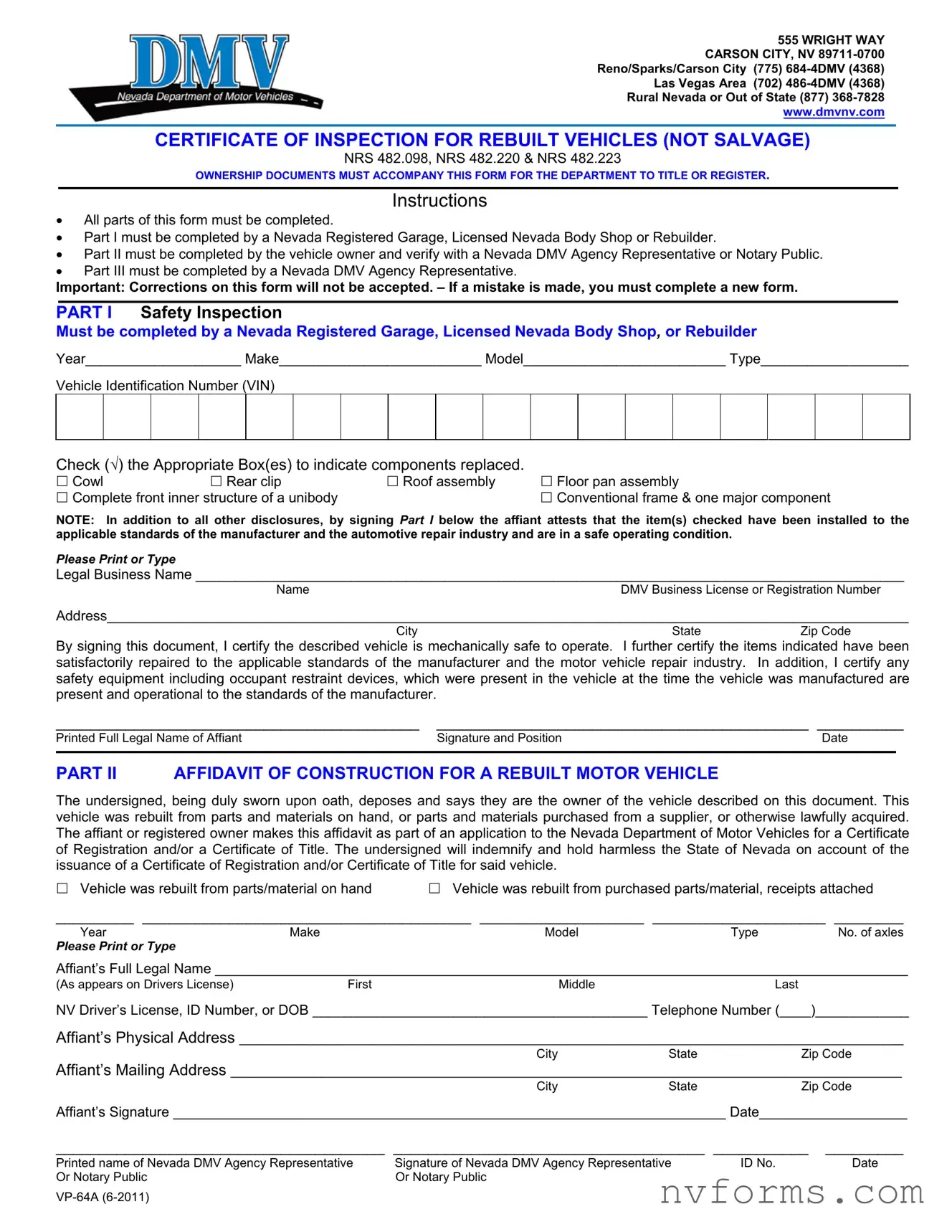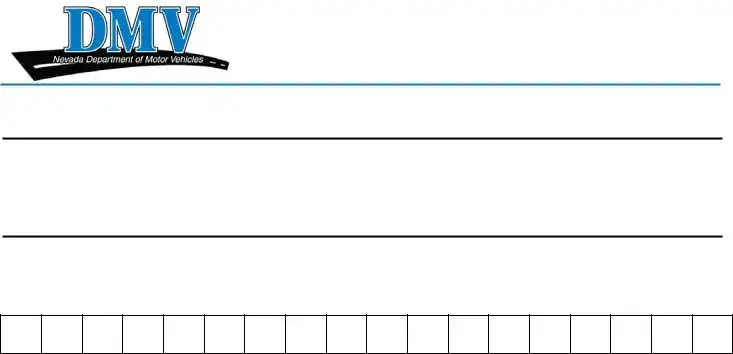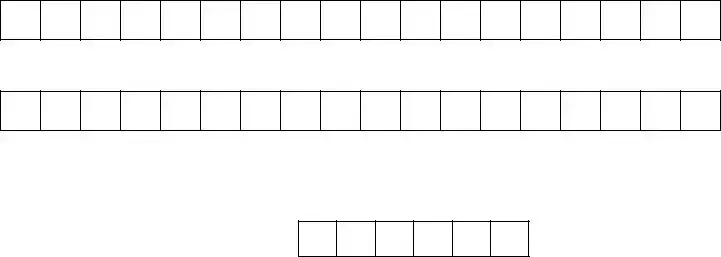555 WRIGHT- WAY
CARSON CITY, NV 89711-0700 Reno/Sparks/Carson City (775) 684-4DMV (4368)
Las Vegas Area (702) 486-4DMV (4368) Rural Nevada or Out of State (877) 368-7828 www.dmvnv.com
CERTIFICATE OF INSPECTION FOR REBUILT VEHICLES (NOT SALVAGE)
NRS 482.098, NRS 482.220 & NRS 482.223
OWNERSHIP DOCUMENTS MUST ACCOMPANY THIS FORM FOR THE DEPARTMENT TO TITLE OR REGISTER.
Instructions
•All parts of this form must be completed.
•Part I must be completed by a Nevada Registered Garage, Licensed Nevada Body Shop or Rebuilder.
•Part II must be completed by the vehicle owner and verify with a Nevada DMV Agency Representative or Notary Public.
•Part III must be completed by a Nevada DMV Agency Representative.
Important: Corrections on this form will not be accepted. – If a mistake is made, you must complete a new form.
PART I Safety Inspection
Must be completed by a Nevada Registered Garage, Licensed Nevada Body Shop, or Rebuilder
Year____________________ Make__________________________ Model__________________________ Type___________________
Vehicle Identification Number (VIN)
Check (√) the Appropriate Box(es) to indicate components replaced.
Cowl |
Rear clip |
Roof assembly |
Floor pan assembly |
Complete front inner structure of a unibody |
|
Conventional frame & one major component |
NOTE: In addition to all other disclosures, by signing Part I below the affiant attests that the item(s) checked have been installed to the applicable standards of the manufacturer and the automotive repair industry and are in a safe operating condition.
Please Print or Type
Legal Business Name ___________________________________________________________________________________________
NameDMV Business License or Registration Number
Address_______________________________________________________________________________________________________
By signing this document, I certify the described vehicle is mechanically safe to operate. I further certify the items indicated have been satisfactorily repaired to the applicable standards of the manufacturer and the motor vehicle repair industry. In addition, I certify any safety equipment including occupant restraint devices, which were present in the vehicle at the time the vehicle was manufactured are present and operational to the standards of the manufacturer.
__________________________________________ |
___________________________________________ __________ |
Printed Full Legal Name of Affiant |
Signature and Position |
Date |
|
|
|
|
PART II AFFIDAVIT OF CONSTRUCTION FOR A REBUILT MOTOR VEHICLE
The undersigned, being duly sworn upon oath, deposes and says they are the owner of the vehicle described on this document. This vehicle was rebuilt from parts and materials on hand, or parts and materials purchased from a supplier, or otherwise lawfully acquired. The affiant or registered owner makes this affidavit as part of an application to the Nevada Department of Motor Vehicles for a Certificate of Registration and/or a Certificate of Title. The undersigned will indemnify and hold harmless the State of Nevada on account of the issuance of a Certificate of Registration and/or Certificate of Title for said vehicle.
Vehicle was rebuilt from parts/material on hand Vehicle was rebuilt from purchased parts/material, receipts attached
_________ ______________________________________ ___________________ ____________________ ________
Year |
Make |
Model |
Type |
No. of axles |
Please Print or Type |
|
|
|
|
Affiant’s Full Legal Name _________________________________________________________________________________________
(As appears on Drivers License)FirstMiddleLast
NV Driver’s License, ID Number, or DOB ___________________________________________ Telephone Number (____)____________
Affiant’s Physical Address ________________________________________________________________________________________________
CityStateZip Code
Affiant’s Mailing Address _________________________________________________________________________________________________
CityStateZip Code
Affiant’s Signature _______________________________________________________________________ Date___________________
______________________________________ ____________________________________ ___________ |
_________ |
Printed name of Nevada DMV Agency Representative |
Signature of Nevada DMV Agency Representative |
ID No. |
Date |
Or Notary Public |
Or Notary Public |
|
|
VP-64A (6-2011) |
|
|
|
PART III |
Completed by a Nevada DMV Agency Representative |
Note: Attach copies of any title or purchase documents showing information of components used from other vehicles.
VIN & Part ________________________________________ VIN & Part________________________________________
VIN & Part ________________________________________ VIN & Part________________________________________
VIN indicated in Part I Verified
Vehicle Inspection Fee
DMV Assigned VIN
VIN Assignment Fee
Different than listed in Part I Year_________ Make________________ Model_____________ Type________________
Reason VIN assigned ________________________________________________________________________________
Odometer Reading (as shown on apparatus)
NO TENTHS
If the vehicle’s odometer apparatus only displays five numbers, please put an X in the first box.
1.The mileage stated is in excess of its mechanical limits.
2.The odometer reading is not the actual mileage. WARNING – ODOMETER DISCREPANCY
3.Exempt – Model year over 9 years old.
Additional comments: ________________________________________________________________________________
_____________________________________ _____________________________________ ________ _____________
Printed name of Nevada DMV Agency Representative |
Signature of Nevada DMV Agency Representative |
ID NO. |
Date |
|
|
|
|
“Rebuilt vehicle” (NRS 482.098) means:
1.A vehicle for which one or more of the following major components have been replaced:
(a)Cowl assembly;
(b)Rear clip assembly;
(c)Roof assembly;
(d)Floor pan assembly;
(e)Conventional frame coupled with one additional major component; or
(f)Complete front inner structure for a unibody.
Note: The term “rebuilt” does not include a vehicle for which the only change is the installation of a truck cab assembly.
Definitions
•“Complete front inner structure for a unibody” (NRS 482.0154) means the weld on structure of a vehicle, including, without limitation, the radiator support. Left and right aprons, upper and lower rails and strut towers, designed and intended to be located forward of the cowl assembly.
•“Conventional frame” (NRS 482.0157) means the main longitudinal structural members of the chassis of a vehicle used as the major support in the construction of the vehicle.
•“Cowl assembly” (NRS 482.018) to mean the forward structural portion of a vehicle to which are intended to be attached all or a part of the windshield frame, fire wall, housing of the instrument panel and hinges for the front doors.
•“Floor pan assembly” (NRS 482.0385) means the pans designed and intended to form the floor of the passenger compartment of a vehicle.
•“Rear clip assembly” (NRS 482.0965) means the entire rear structural portion of a vehicle designed and intended to be located behind the rear seat of the vehicle.
•“Roof assembly” (NRS 482.106) means the structural parts of a vehicle, including, without limitation, more than one-half of the vertical roof supports, the framework of the roof and the exterior metal skin that together are designed and intended to be located over the passenger compartment to form the roof of the vehicle.
VP-64A (6-2011)


